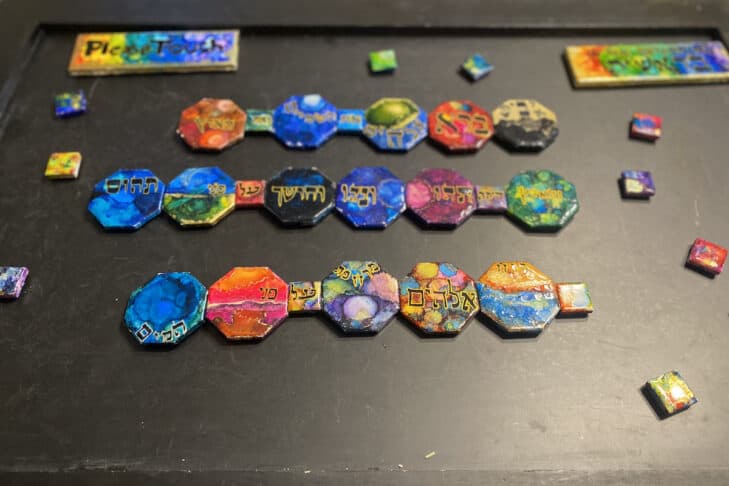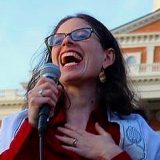Two summers ago, a friend showed me how to use alcohol paint on tile. I fell in love with the small vials of color, the vibrant splotchy designs I could only partially control, and the satisfaction of layering Hebrew calligraphy over it all. In the evenings after putting my son to bed, I would run to my paints. Over the next few months, I covered tile after tile with color and words. I learned how to use a blow torch on resin to make the pieces shiny and durable. A year later, my piece, “Bereishit/In the Beginning: A Tactile Meditation on Genesis 1:1-2,” a collection of tile magnets, hung in Hebrew College’s Centennial Art Exhibition. It was recently featured on Kolture.com as well.
This was not the first time I found myself practicing a new creative medium with the fervor of a ba’alat t’shuva, a newly observant Jew. At 10, I taught myself to weave complex tapestries on a lap loom, images of landscapes and animals appearing in the weft beneath my fingers. In college, I picked up the alto saxophone and spent hours in the Oberlin Conservatory practice rooms, happily sounding like a terrible saxophone major. At 31, recently back from Israel, I produced “Guesthouse,” a full-length album of original folk songs.
These days, as I focus on my writing, I am often compelled to stay up late and take dictation as an essay tumbles out, fully formed onto the page. My muse is unconcerned with medium consistency. She throws me into the visual and textile arts, music, and all forms of writing. Like mitzvot, I experience each project as sacred, mandatory, and a way to connect to God.

I have always been puzzled by the extent of my devotion to these projects. Where does the passion come from? Why does following my creative drive feel both compulsive and healthy?
A few months ago, I found the answer.
Last year, I made the life-changing discovery that I am Autistic. Neither a tragedy nor a medical disorder, Autism is a different but valid way of being human that comes with great challenges but also great strengths. Like many other masked Autistics who are discovering the identity in adulthood, I was able to leverage my particular Autistic strengths for decades, excelling in academic environments and performing well in jobs. All the while, my significant challenges with sensory processing, nervous system regulation, hyper empathy, and fatigue were hidden or misdiagnosed until I learned about Autism while parenting my child.
As I embrace an Autistic identity, I finally understand the fervent drive behind my creativity. A common Autistic trait is engaging in special interests—a skill, project, or subject to which an Autistic person will devote a great deal of time exploring or mastering. We have Autistic people and our special interests to thank for major innovations throughout human history (computers and relativity, to name two famous examples), but special interests need not change the world. They can be modes of play (my son makes his own version of everything he can), or a deep dive into a fandom (I had memorized every lyric of “Into the Woods” by age 8). For some, special interests last a lifetime. For others, they shift every few months or years. But no matter the timeframe or topic, special interests are a cornerstone of Autistic wellbeing. They bring us meaning and satisfaction, help us self-regulate, and are often the primary way we learn and connect to other people. My creative projects—and my climate activism—are perfect examples.

Autistic is a beautiful way to be, and the only one I will ever know. It is also a challenging disability, and it’s challenging in a particular way for anyone who grows up without neurodivergent-affirming therapies or a broader Autistic community of support. As I come to respect my real limits and stop pushing myself to outwardly excel, I have discovered that creative self-expression is a core principle of my life, as important to my wellbeing as food, sleep, or exercise. I have to say no to a lot these days, but I cannot say no to my muse. I am at work on a memoir and posting about my neurodivergent journey on Instagram. My first picture book, “The Tide Is Rising: A Climate Movement Anthem,” is forthcoming from Beaming Books in 2025. And the alcohol paints still beckon, the colors and words unfolding under my fingers as a form of prayer.
This post has been contributed by a third party. The opinions, facts and any media content are presented solely by the author, and JewishBoston assumes no responsibility for them. Want to add your voice to the conversation? Publish your own post here. MORE



